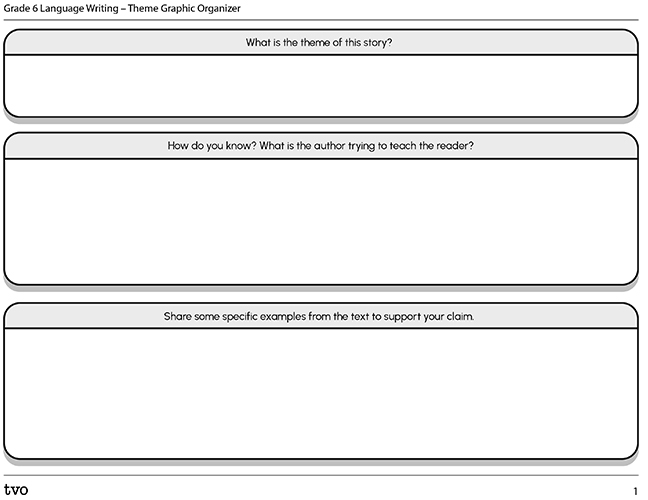Minds On
A theme is longer than one word
As you read or listen to stories, you should be able to identify a story’s plot, setting, characters, problem, and solution. Another essential element of a story is the theme. It can take time to unpack and understand a story’s theme, but it’s there and it’s important.

The theme is the story’s “big idea” or message that the author wants us to take away. It goes deeper than the main idea and requires some interpretation from the reader.
Here are examples of some common story themes:
- Coming of age (growing up) is the time of our greatest happiness and sorrows
- Discovery is worth the risk
- Love conquers all
- One must take a side in the battle of good vs. evil
- Courage does not solve all problems
- People will do more than they imagined they could do in a life-or-death situation
- Loss can be positive
Student Success
Think-Pair-Share
Identifying theme
Work with a partner or independently to brainstorm the titles of books or movies that fit each of the themes listed above. How do you know? Think of specific events or details from the story to support your thinking. Record your thinking in writing or with audio.
Note to teachers: See your teacher guide for collaboration tools, ideas and suggestions.
Action
Themes in nonfiction
Themes exist in real life too. Access the following video, “Syrian Refugees in Northern Ontario.” In this video, you will learn about the Alsalamat family and their experiences fleeing the civil war in Syria and arriving in Sault Ste. Marie, Canada as refugees.
Student Success
Think-Pair-Share
If possible, consider the following questions with a partner:
- What is the theme of the Alsalamat family’s story?
- What can we learn from hearing this story?
- What are you left thinking about?
Note to teachers: See your teacher guide for collaboration tools, ideas and suggestions.
Themes in current events
Select and research a current event on a topic you are interested in. As you read, think about the theme of the story. Use the following fillable and printable Theme Graphic Organizer to organize your ideas. You can also record your ideas in your notebook.
Use your notes from the graphic organizer to construct a paragraph. Make sure to include the following:
- an introduction sentence
- a concluding sentence
- evidence from the text to support your thinking about the topic
- accurate spelling and grammar
- sentences are complex and help develop the theme
Consolidation
Constructing stories
Select one of the themes listed in the Minds On and create a story that centres around that theme. Some of these themes are included below. Make sure that your reader is able to easily identify the theme. What is the message or lesson that you want your reader to take away with them?
- courage does not solve all problems
- people will do more than they imagined they could do in a life-or-death situation
- loss can be positive

If possible, share your story with a partner. Are they able to:
- identify the theme correctly
- explain the message or lesson from the story
- use evidence from the story to explain the theme
Revise your writing based on the feedback you received.
Reflection
As you read through these descriptions, which sentence best describes how you are feeling about your understanding of this learning activity? Press the button that is beside this sentence.
I feel...
Now, record your ideas using a voice recorder, speech-to-text, or writing tool.
